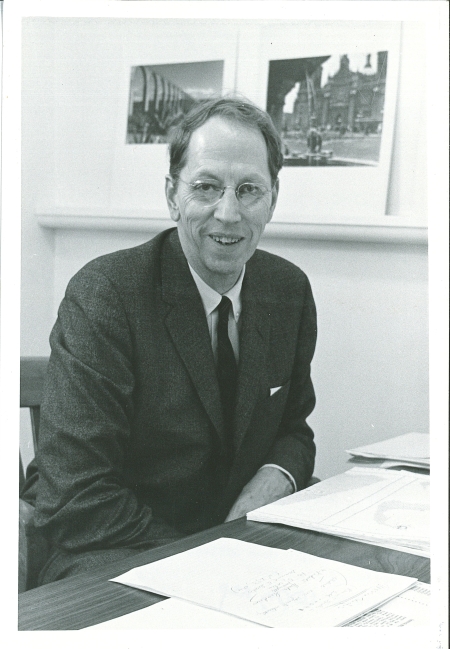The message arrived on a cold January day: “Greetings from the Museum of Modern Art. We'd been out on a research trip to see the Papers of Howard T. Fisher last Spring but are just now settling on the final checklist for our upcoming exhibition Emerging Ecologies: Architecture and the Rise of Environmentalism (Sep 2023) and are hoping to borrow an object from the Harvard University Archives.”

While the University Archives receives requests to use our collections from all corners of the globe, it is admittedly exciting when the request comes from one of the largest and most influential museums of modern art in the world.
Emerging Ecologies examines how architects, including Fisher, responded to the environmental crisis of the 1960s and 1970s. Howard T. Fisher (1903-1979), Director of the Graduate School of Design’s Laboratory for Computer Graphics and Spatial Analysis in the 1960s, was an architect and urban planner whose work included General Houses, a company he founded in the 1930s to design and build low-cost, prefabricated housing.
Fisher's work at Harvard left an enduring legacy in computer cartography and environmental design. Fisher developed the Synagraphic Mapping (SYMAP) computer program, which was “a computer program for producing maps which graphically depict spatially disposed quantitative and qualitative information.”[1] SYMAP allowed complex environmental data to be displayed in new ways and was one of the programs that laid the foundation for the geographic information systems (GIS) that are integral to nearly every mapping application we use today.
The object that the Museum of Modern Art (MoMA) requested for Emerging Ecologies is a set of 27 SYMAP modules which Fisher developed as models for creating his SYMAP program.

Each module is a paper cube, four inches on each side, which nest together to form a larger, cohesive cube that can be separated on different planes to examine internal cross sections. The information that forms each cube’s pattern would have been carefully plotted, printed, cut out, adhered to cardstock, and then folded into its final shape. The SYMAP modules are a staff and visitor favorite at the Archives because they provide the unique opportunity to interact with early computer-generated data in a three-dimensional, physical form.
Given the uniqueness and complexity of this item, executing this loan was not as straightforward as those we normally handle.
David Remington and Bob Zinck in Harvard Library Imaging Services were key to providing a series of high-resolution images of the multiple-sided modules, and getting the images to the MoMA team quickly for their exhibition catalog. Virginia Hunt (University Archivist) and Juliana Kuipers (Associate University Archivist for Collections Development and Records Management Services) had to determine an insurance value for a completely unique object with no available comparisons.
Due to the complexity and delicateness of these modules, packing and shipping them proved also to be a challenge, given that the fine arts movers had to maneuver their truck through Harvard Yard, dodging the chilled water line and Pusey moat construction projects — as well as schedule around the endless downpours that plagued us this July.
It was not lost on us that this exhibit and loan come at time when our profession is reckoning with conflicting responsibilities to collections preservation and environmental stewardship. These same questions have echoed between professions and decades, as complex and layered as the patterns on the modules themselves.
Emerging Ecologies: Architecture and the rise of Environmentalism at the Museum of Modern Art opens to the general public on September 17, 2023 through January 20, 2024.
[1] Fisher, Howard T. Papers of Howard T. Fisher, circa 1929-1974. HUGFP 62.7 Box 21, Harvard University Archives